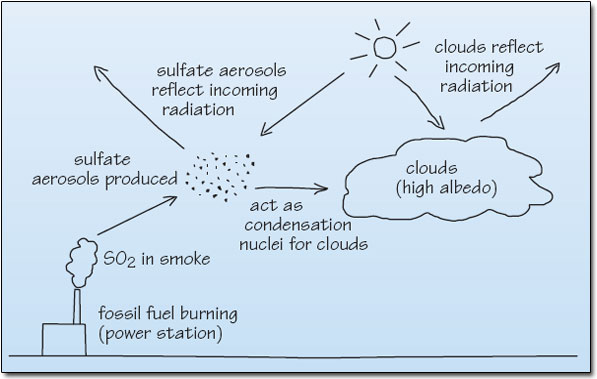1 Global climate and the greenhouse effect
1.8 End of section questions
Question 5
Information on the different albedos of various types of surface was given in Section 1.2.1. Given that information:
- (a) Explain how a cover of snow or ice is likely to affect the amount of incident solar radiation absorbed by land or sea.
- (b) According to the TAR, there has been a 20% decrease in global forest area since 1850. If we assume that dark forest cover (with an average albedo of 10 – 20%) has been replaced by farmland and pasture with an albedo similar to that of grassland (say, 35%), why might this have contributed to the radiative forcing of climate over the past 150 years? Would the forcing be positive or negative?
Answer
- (a) Both snow- or ice-cover on land and sea ice have a very high albedo (up to 90%), and so will reduce the amount of solar radiation absorbed.
- (b) Replacing large areas of dark forest cover with vegetation that reflects ahigher proportion of incident solar radiation effectively increases the planetary albedo; this constitutes a negative radiative forcing. (See Figure 36, Section 2.6.1 for an estimate of the effect this has had.)
Question 6
One suggested strategy for reducing anthropogenic emissions of methane is to capture the gas generated in landfill sites, and pipe this away for use as a fuel (for local domestic needs, say). But burning methane produces CO2. Why might this still be a sensible option if the overall aim is to reduce the total greenhouse forcing of climate in future?
Answer
The main point here is that methane is a more powerful greenhouse gas than CO2 (at least on a mass-for-mass basis; Table 2, Section 1.6).
Question 7
Draw a simple annotated diagram to illustrate the radiative effects (both direct and indirect) of tropospheric sulfate aerosols. Include in your diagram the link with human activities.
Something along the lines shown in Figure 21 would be appropriate. Note how a simple annotated diagram like this can communicate a lot of information, much of which would not need to be repeated in detail in the accompanying text (useful if you are working to a tight word limit). Note too that diagrams should always have a caption.

